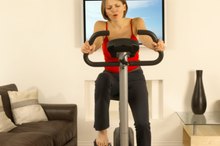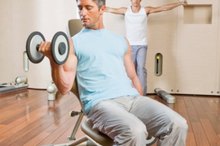What Happens to Your Lungs When You Exercise?
When resting, your lungs breathe in and out up to 25 times per minute 1. Their basic task is to bring in oxygen to the body via air and exhale carbon dioxide -- a substance your body can't use. However, when you exercise your lungs are put under greater strain to perform this task 1. You may feel like you have to breathe deeper and faster to keep up with your body's demands.
If you are experiencing serious medical symptoms, seek emergency treatment immediately.
Breathing Mechanics
Your lungs are made from a spongy material that expands when you breathe in air. They're protected by your ribcage and supported at the bottom by a layer of muscle called the diaphragm. Inside the lungs, tiny sacs called alveoli sit at the end of a network of very thin tubes. The alveoli allow the transfer of oxygen from the air to the blood. This transfer is basically the same whether you're resting or exercising.
- Your lungs are made from a spongy material that expands when you breathe in air.
- The alveoli allow the transfer of oxygen from the air to the blood.
Exercise
How the Heart & Lungs Work During Exercise
Learn More
Exercise means the muscles in your body need more oxygen to work 1. To provide the extra oxygen, your brain tells your diaphragm and rib muscles to work harder. As your diaphragm flattens out, it enlarges your chest cavity. Because of the relative pressure change, air rushes into your lungs 1. Your lungs then expand to fill your enlarged chest cavity. When your lungs reach near their maximum volume when exercising, your diaphragm tightens once again and forces the air out.
- Exercise means the muscles in your body need more oxygen to work 1.
- When your lungs reach near their maximum volume when exercising, your diaphragm tightens once again and forces the air out.
Circulatory Changes
Your pulmonary vessels transfer blood to and from the lungs. When you exercise, your pulmonary vessels increase their blood volume up to four times. The overall volume of blood in the lungs rises by around 10 percent, allowing for the absorption of more oxygen for the heart to pump around the body via red blood cells.
Extreme Capacity
How Does Running Increase Lung Capacity?
Learn More
A professional athlete training at his highest rate can increase his breaths per minute to around 40 to 60, according to the British Lung Foundation. That equates to 100 to 150 liters of air filling the lungs and emptying again every minute. This is why lung capacity and the ability to control breathing when exercising can help improve athletic performance.
Related Articles
References
- Pediatrics: Circulatory Changes in the Lungs During Exercise
- National Cancer Institute SEER Training Modules. Anatomy of the lung.
- Kids Health from Nemours. Your lungs & respiratory system.
- Teach Me Anatomy. The lungs. October 22, 2019.
- Chaudhry R, Bordoni B. Anatomy, thorax, lungs. StatPearls. Updated January 13, 2019.
- Poe E, Granite G. Anatomical lung variations: A study conducted on cadaveric specimens. International Journal of Anatomical Variations. May 24, 2019.
- George BM, Nayak SB, Marpalli S. Morphological variations of the lungs: a study conducted on Indian cadavers. Anat Cell Biol. 2014;47(4):253-258. doi:10.5115/acb.2014.47.4.253
- Kc S, Shrestha P, Shah AK, Jha AK. Variations in human pulmonary fissures and lobes: a study conducted in Nepalese cadavers. Anat Cell Biol. 2018;51(2):85-92. doi:10.5115/acb.2018.51.2.85
- The Lung Association. How the lungs work. December 10, 2016.
- Medline Plus. Lung disease. Updated July 28, 2018.
- World Health Organization. The global impact of respiratory disease.
- NIH U.S. National Library of Medicine Genetics Home Reference. Idiopathic pulmonary fibrosis. April 28, 2020.
- American Lung Association. Learn about sarcoidosis. February 27, 2020.
- Hoeper MM, Ghofrani HA, Grünig E, Klose H, Olschewski H, Rosenkranz S. Pulmonary hypertension. Dtsch Arztebl Int. 2017;114(5):73-84. doi:10.3238/arztebl.2017.0073
- Bĕlohlávek J, Dytrych V, Linhart A. Pulmonary embolism, part I: Epidemiology, risk factors and risk stratification, pathophysiology, clinical presentation, diagnosis and nonthrombotic pulmonary embolism. Exp Clin Cardiol. 2013;18(2):129-38.
- American Lung Association. Lung capacity and aging. March 11, 2020.
- MedlinePlus. Lung function tests.
Writer Bio
Based near London, U.K., Peter Mitchell has been a journalist and copywriter for over eight years. Credits include stories for "The Guardian" and the BBC. Mitchell is an experienced player and coach for basketball and soccer teams, and has written articles on nutrition, health and fitness. He has a First Class Bachelor of Arts (Hons.) from Bristol University.









